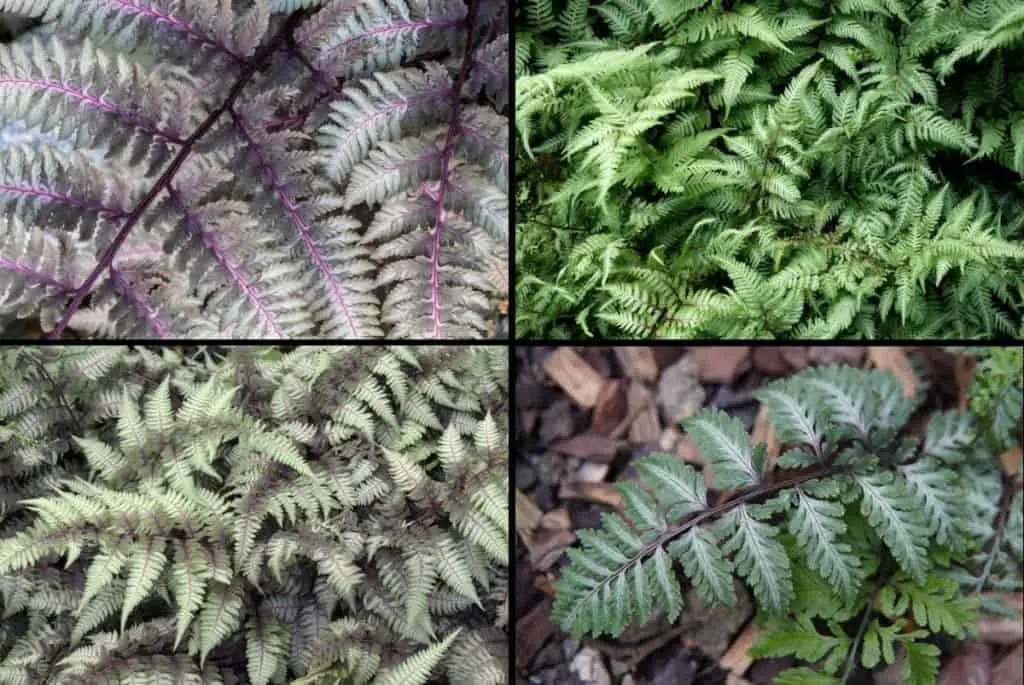Undoubtedly one of the most popular and distinctive ferns in cultivation, the Japanese painted fern comes in several varieties and cultivars, all with their own delicate beauty. The variety has won many awards in recognition of its appeal, including an RHS “Award of Garden Merit”, and Perennial plant association, “Perennial of the year”.
Japanese painted ferns have a reputation for being temperamental, with some growers reporting difficulty getting reliable growth and color, while others have great success. The likely causes of this variability are soil moisture and pH, and how much sun the ferns are exposed to at different times of the day.

Common names
- Japanese painted fern
- Painted lady fern
Botanical names
- Athyrium niponicum ‘Pictum’
- Athyrium goeringianum ‘Pictum’
- Anisocampium niponicum
Growth habit
Japanese painted ferns are deciduous, dying back in the late fall and returning in the spring. They form a small clump of low-hanging, spread-out fronds that lie horizontally rather than erect. The rhizomes can spread through the soil, forming a row or low hedge of small clumps, but this is slow and easily managed.
The sprawling habit of the foliage means that the painted fern rarely grows higher than 1-2 feet even under perfect conditions.
Hardiness
Athyrium niponicum originates, as the name suggests, from Japan. It is reliably hardy to USDA zone 6 (-10 to 0 °F, -23 to -18 °C), but some varieties can reportedly survive in zone 5. It can therefore be grown outdoors in all but the northern and midwest states, and northern Europe, where winters can be too harsh.
Sun exposure
Japanese painted ferns need full or partial shade, and can be badly scorched and stunted by too much direct sun. As a counterpoint to this general principle, morning sun can promote more colorful foliage for the Pictum variety, and fronds will tend back toward the green in very shady areas. Cooler weather in summer can also improve coloration.
Planting in pots that can be moved would give some control over these factors, if the beauty of the fronds is of principal concern.
Water
Soil moisture conditions is the most important factor in the success of Japanese painted ferns. They like regular watering, and need moist but well-drained soil to thrive. Planting in dry shade leads to stunted growth and poor frond condition.
Some growers also report that tap water can make these ferns sickly – possibly due to hard water minerals, or alkaline pH, or even chlorination. If possible, therefore, collected rainwater is preferred when a dry period requires supplemental watering.
Soil conditions
Acid or neutral soil conditions are favored by the parent Athyrium niponicum, but some varieties and cultivars can tolerate alkaline pH. Soil enriched with compost or leaf mold is ideal, and additional fertilizer is not needed. Good drainage is essential, as waterlogged or heavy clay soil is not tolerated.
For potting, a standard multipurpose mix supplemented with grit (or other coarse material) is fine.
Propagation
Propagation of Japanese painted ferns is best done by division, because the color and patterning of the fronds does not always come true from propagation through spores. The majority of specimens bought from nurseries and garden centers are propagated in this way, although many of the cultivars and varieties that have especially vibrant foliage have been obtained from patient selection of new fernlings from fertilized spores.
To divide a well-established plant, the simplest way is to isolate a distinct clump from a drift of spreading clusters and replant immediately. If new clusters cannot be separated easily, a larger specimen can be lifted, and the tangle of rhizomes divided into three or four separate sections. Ensure there is a good amount of rhizome, root and fiddleheads (or fronds) on each section.
Replant immediately, and water thoroughly. Keep watering for a couple of weeks to be sure the transplanted ferns will establish well in their new location.
Varieties and cultivars
There are a wide range of varieties and cultivars of Japanese painted ferns. The main variety Aythrium niponicum ‘Pitcum’ originates from a Lady fern (Aythrium filix-femina), and has a similar general shape, with delicate, feathery fronds. The Pictum variety has beautiful wine-red or burgundy stems and midrib, with silvery patterning on the pinnae that blends into shades of pale and dark green on the outer edges.
Propagation from spores results in a diverse range of progeny, with some plants reverting to a generally green coloration similar to a Lady fern, but others having strikingly different patterns and colors. These cultivars can be purchased, and a wide range are now available. Examples include the more silvery ‘Ghost’ ‘Silver falls’, and ‘Pewter Lace’ varieties, the deep red midribs of ‘Ursula’s red’ and ‘Regal red’, and the all round showiness of ‘Metallicum’.
The ‘Brandford beauty’ and ‘Brandford rambler’ varieties have a more robust growth than other Pictum cultivars, with Athyrium ‘Godzilla’ being the most copious and bushy of the painted ferns.
There are a large, and ever growing number of varieties and cultivars to choose from. A few years ago, the Chicago botanical society ran a test survey of a wide range of Lady fern and Japanese painted fern varieties, establishing the ideal conditions and consistency of presentation for each.

The Japanese painted fern, in all its various forms, is a must-have for fern lovers. It is one of the most beautiful, interesting and eye-catching varieties, it graces any shade garden, and with the right care regime it can thrive in all but the coldest climates.
